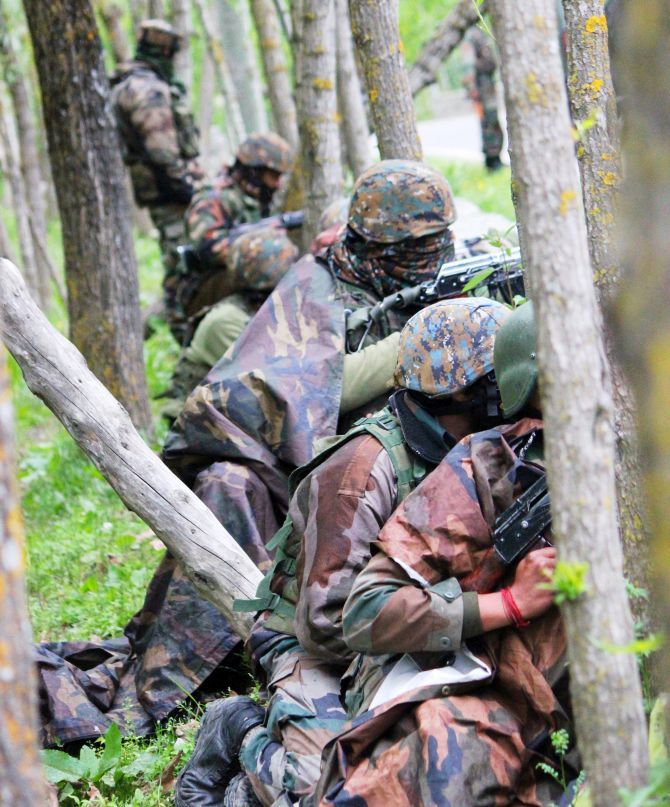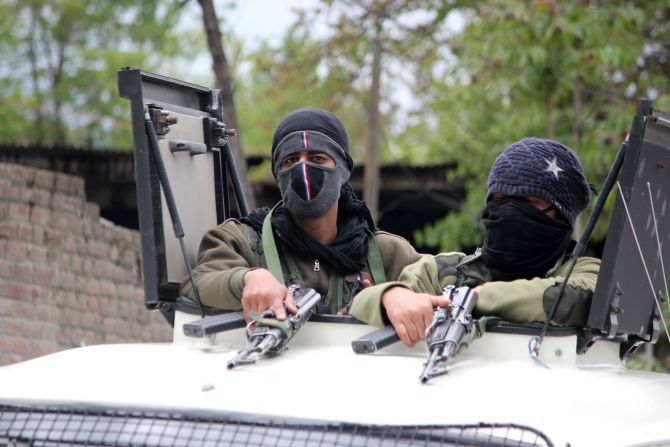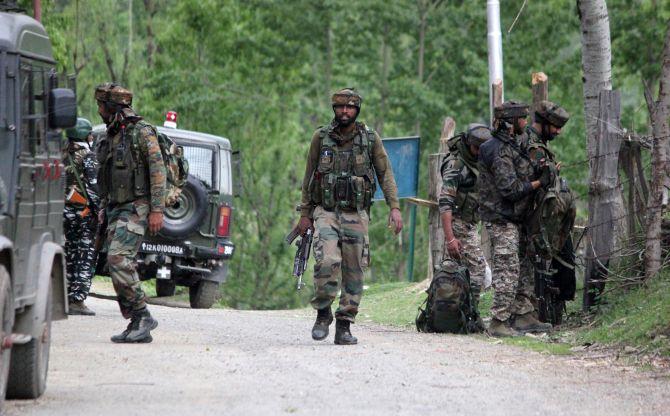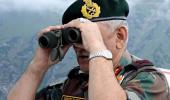Lieutenant General Syed Ata Hasnain (retd) explains what may have happened during the Indian Army's anti-terrorist operation in Kashmir in which four soldiers and one policeman, including the commanding officer, 21 Rashtriya Rifles, made the supreme sacrifice for the Motherland.

This starts with deep regret at the loss of five valuable Indian lives in the Handwara anti-terrorist operations in Jammu and Kashmir which went on for the last 36 hours or so.
The late Colonel Ashutosh Sharma, Commanding Officer, 21 Rashtriya Rifles, and his brave officers and men need the nation's salute for their courage and their sense of commitment.
It is also a good time to set a lot of perceptions and ideas in order, from the disorder which prevails in the information domain dominated by social media. The kind of questions arising from an ill-informed public is downright damning and extremely demotivating for frontline soldiers.
A few facts first. Some terrorists (number indeterminate) probably infiltrated across the LoC (something always possible especially in this season) and reached the traditional reception areas in the Rajwar forest adjoining Handwara, the fairly notorious North Kashmir town.
This is the season for infiltration because April-May is the time when Pakistan attempts to infiltrate maximum terrorists across the LoC.
The ice and snow covering the anti-infiltration obstacle system (AIOS) during winter is beginning to thaw and the fence beneath is in a derelict state facilitating terrorists to walk across it.
There are ambushes to prevent such movement, but gaps can always be exploited.
The Pakistani terrorist group successfully reached the Rajwar forest and moved into the urban zone to access potential safe houses.
An intelligence alert about their presence sent the local 21 Rashtriya Rifles (21 RR) unit into response. What happened thereafter is unclear.
The terrorists reportedly attempted seeking shelter by hostage taking. The RR troops reached and undertook operations, two terrorists were killed.
The CO and company commander probably entered a house or a cluster of houses with a small team and then things went wrong, resulting in the loss of communication with them.
What finally happened is best known to the troops of 21 RR and their officers and there is no need to do a post-mortem in the public domain.
In due course, an inquiry will establish the chain of events as close to the actual as possible by piecing together the narrative from versions of the soldiers who were participants in the operation.
It needs to be known that this unit is one of the most experienced units in the Kashmir valley and has some of the highest achievements.
It has battled hardcore foreign terrorists, especially Pakistanis who are most attracted to the routes into the Rajwar forest and thence to Handwara and Sopore.

There are other connected issues that are being raised. After eight months of stability post August 5, 2019 there is an eruption of violence in the terrorist domain in Kashmir. Mobs and street turbulence are not anywhere on the horizon.
Since April 1, 2020 almost 30 plus terrorists have been neutralised near the LoC and the hinterland.
The Indian Army has lost nine soldiers plus two more from shelling in the Uri sector.
While the achievements are good, the losses are upsetting and the statistics do not appear professionally very comfortable.
However, anyone who studies Kashmir would know that taking ratios in short brackets of time is indicative of nothing.
Casualty ratios are always seen as averages over time. In early 2017, the ratio had come down to par with a soldier lost to every terrorist killed. To casual observers that is terrible.
15 Corps restored these to approximately 1:5 (own: terrorists) in 2017 and 2018. Usually, it is seen when the strength of the terrorists drops to a low the averages usually go more in their favour. There are various reasons for this outside the current scope of discussion.

People wonder why such emergence of violence has occurred when all was under control for eight months. The answer is not difficult. Any further absence of violence will contribute to the idea of normalcy which works in India's favour.
For Pakistan that is like placing more nails in its own coffin after it found its options running out.
A desperate attempt is on to enhance the strength of terrorists through infiltration into North Kashmir explained in this Rediff.com column.
Much more is likely to follow as the season opens up even as attempts to balance South and North Kashmir are going on in terms of terrorist strength and violence.
The system of 'infiltration by attrition' followed by the Lashkar-e-Tayyiba's Muhammed Sayeed believes in sending hundreds of terrorists across the LoC in repeated attempts to get across with many dying in the bargain, but a handful succeeding in getting through.
Life is of no consequence to these cadres and their leadership. That is where the major challenge for the Indian Army lies this summer; the prevention or minimisation of infiltration.
The other issue that is being spoken about by an increasingly vocal younger segment on social media is about the availability of technology to troops in Kashmir and the standard operating procedures that are followed for such activities as hostage negotiations, house clearance and surveillance.
No doubt the viewing of popular Israeli serials such as Fauda on Netflix has enhanced knowledge of people about such operations. It augurs well on the future of strategic culture, but tends to be extremely critical and unnecessarily negative about our own operations.
It needs to be known to people that Israel will not project its failed operations or those in which it suffered large scale reverses but rather only successful ones with some slick camera work.
Israeli technology is legendary and there is no dispute on the need for more technology for operations in the Kashmir valley. However, I am aware that in the last ten years since my time in the Kashmir valley things have improved many times over.
Yet technology will always be less than required to be deployed unless funding and procedures are both eased. Post COVID-19 this is unlikely.

The standard operating procedures of units such as 21 RR are outstanding, but they can be as good as the matching they have with the situations that arise.
There is no tailor made SOP for each contingency because that is humanly impossible. Experience tells us how to adopt these SOPs to the situation.
In spite of these, an odd occasion will arise where no SOP exists and improvisation is resorted on the spot. That is what leadership is all about.
Most times it will succeed, but at odd time it will fail. There is no recipe for hundred percent success; the faster people understand it, the less will they focus unfair criticism against troops and their leadership.
There is much questioning about the forward presence of the CO for an operation involving 4 or 5 terrorists. This issue has come up many times in the past and the Indian Army has never believed in interference in the concept of unit command nor will it do so now.
We have lost COs in the past and the late Colonel Ashutosh Sharma, twice a recepient of the Sena Medal, is the second CO of 21 RR to be killed in action; the first was the late Colonel Rajender Chauhan, Sena Medal, in August 2000.
In offensive operations in conventional war the CO may direct his forward companies from the firm base and move up only if there is an imminent failure staring a unit in the face.
In defensive operations he may move to one of the sub-units under attack and yet remain at the depth platoon to direct operations.
However, the Kashmir hinterland is all about irregular operations as part of hybrid war; there is no front and no rear here and terrorist contacts can take place at the HQ itself.
The CO's presence is therefore necessary at the point of contact or just in its vicinity. The vicinity can be converted into the point of contact in a matter of seconds due to the rapidity of operations.
Company commanders launch operations based on the inputs they acquire and the success of that is ensured by the presence of the CO to back up and retrieve in case of contingencies.
If located at his headquarters he will anyway have to move up should there be contingencies. It is old world thinking to imagine a CO sitting far away and directing.
The Indian Army boasts of the leadership qualities of its officer cadre and the concern for the safety of its soldiers. The CO's forward presence always ensures that. Nothing is going to stop this basic value system of the Indian Army.
We are at the beginning of a fresh campaign by Pakistan to up the ante in Kashmir. The Pakistan campaign cannot succeed in the light of many proactive measures taken by the Indian security system and will once again wear itself out.
In the process there will be many successes gained by India's security forces, but an odd reverse too. This was one of them.
Lieutenant General Syed Ata Hasnain (retd), former general officer in commanding, 15 Corps, Srinagar, is one of the best informed commentators on anti-terrorism operations in the Kashmir valley.










